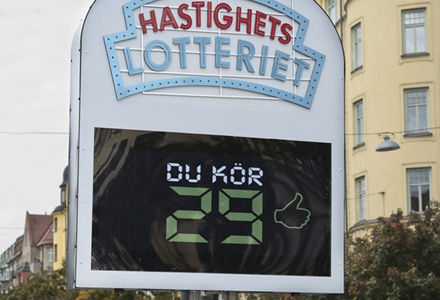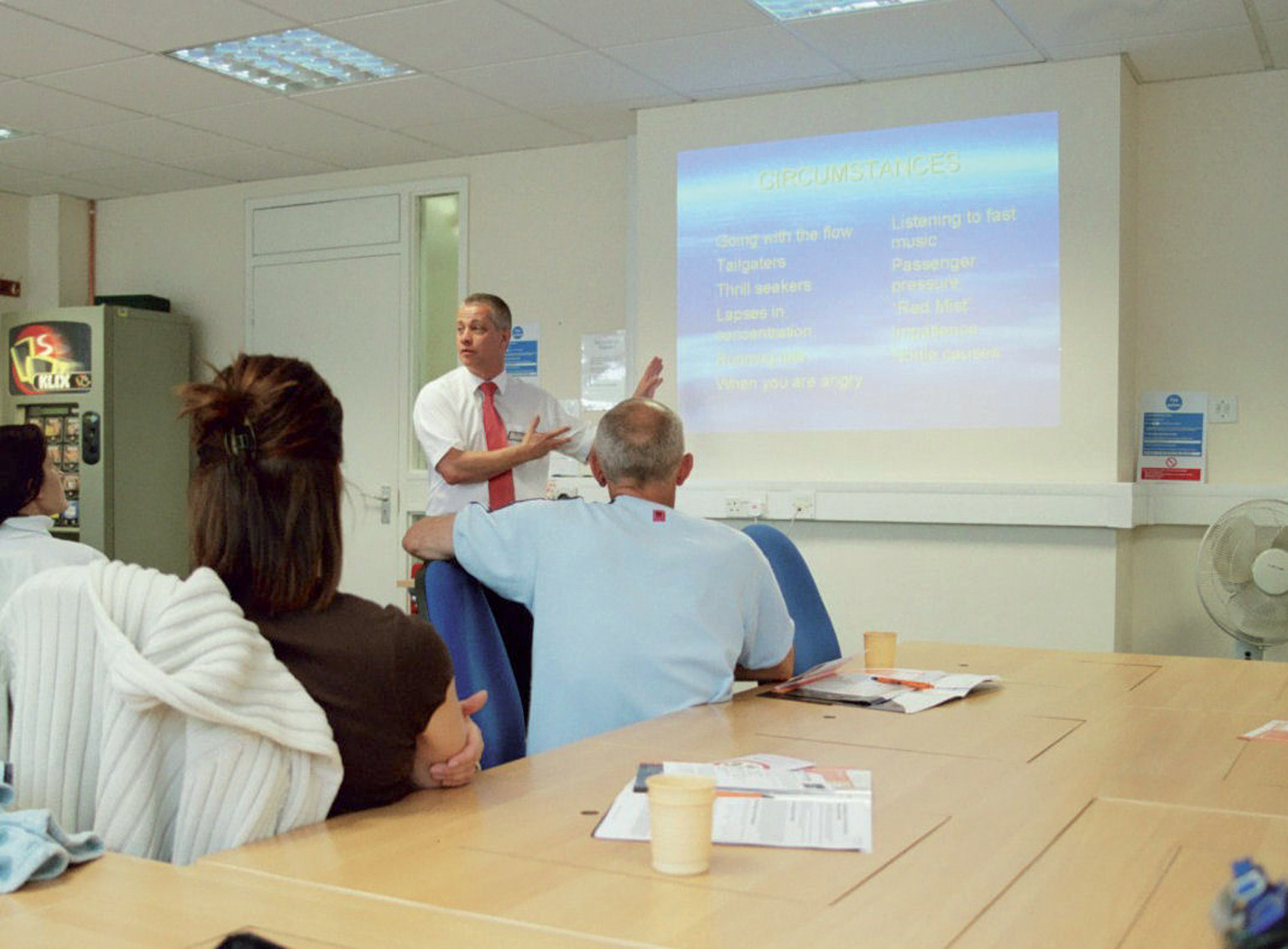
In Sweden, marketing company DDB Stockholm employed a mock speed camera as part of a promotional campaign for automotive manufacturer Volkswagen. The result was worldwide online interest and promotion of the debate over excessive speed to the national level
A developing trend in traffic management policy is to look at how to induce road users to modify their behaviour by incentivising change rather than forcing it through the application of penalties. There have been several studies conducted into this; an example recently reported in this magazine is the work done in the Netherlands to find alternatives to road user charging which encouraged drivers to travel at off-peak times, thus mitigating rush-hour congestion (see 'Root causes', pp.41-42, ITS International May-June 2010).More specifically in the area of enforcement, the idea of 'soft' enforcement, or compliance, has been around for some time and is manifested (for example) in the form of dynamic speed advisory signs which have been deployed around the globe over the past few years. Notwithstanding the introduction of such measures, the issue of speed and automated enforcement remains a contentious one and there are regular challenges in the courts over its legality and perceived infringement on the right to privacy.
Nothing, however, is more dangerous than ignorance and enforcement experts often cite education as the key to acceptance. In Sweden, direct marketing company DDB Stockholm has recently given the education process a rather different slant. The resultant Speed Camera Lottery, which grew out of
The Fun Theory
When Volkswagen Sweden asked for help to increase interest in its BlueMotion range of eco-technologies, DDB Stockholm faced a bit of an issue.Prime amongst these was that there was already a wealth of environmentally oriented products on the market. DDB Stockholm's solution was to come up with a campaign which looked to change people's behaviour on the basis of moving from a position of 'we should do something' to 'we want to do something'. The Fun Theory therefore set out to find ways of making change desirable. The campaign would highlight the fun aspects of VW's eco-oriented products and would push the philosophy behind the innovations rather than the technology itself. In the process VW, as the sponsor behind the whole undertaking, would be positioned as a forward-thinking brand.
To test the Fun Theory, DDB Stockholm conducted three trials in the Swedish capital. All were intended to see whether it was possible to encourage people to make changes to their habits in ways which were to the betterment of society as a whole.
The first trial, the Piano Stairs, looked at how to encourage people to take more exercise. On the staircase of a subway station, mock piano keys were installed on the stairs next to an escalator and walking on these caused them to play tunes. The second set out to encourage people not to litter, and a bin in a local park was fitted with a device which, when litter was deposited, produced a sound effect which simulated great depth; this was the World's Deepest Bin. The third, the Bottle Bank Arcade, made recycling fun by turning it into an arcade game - depositing bottles allowed users to accrue points, which were displayed on a screen.
The three trials proved the concept's validity and films of the trials were published on the campaign's website. The Fun Theory soon became one of the most successful viral campaigns in the world; to date over 20 million people have seen its films on YouTube (see Sidebar, 'Media interest').
The next step was the Fun Theory Award, which was also posted on the website. This, an international competition in which people could suggest fun ways of improving life, attracted over 1,000 entries from 35 countries. It was Kevin Richardson from San Francisco who suggested the Speed Camera Lottery. His concept was simple: each person caught speeding by a camera had to pay money into a pot. To be in with a chance of winning a chunk of the money, drivers had to observe the speed limit in the area around the camera.
Theory into practice
Sweden, like other countries, has strict rules governing privacy and the application of automated enforcement. This meant that a standard speed camera could not be used by the Fun Theory team. Instead, says DDB Stockholm's social media director Michal Bugaj, a local inventor was invited to come up with a radar-triggered camera set-up which captured digital images of all passing vehicles. Unlike a conventional speed enforcement camera, which captures images of those who break a speed limit, the Speed Camera Lottery's camera recorded images of those who drove at the correct speed. The camera was linked to a speed advisory sign which gave motorists instant feedback. In addition to a vehicle's speed, this also displayed a thumbs-up or a thumbs-down symbol as appropriate. None of the captured images of offenders were passed to the police for further action."In all, it took us six months to gain all the necessary permits to take the project forward," Bugaj continues. "One of the biggest challenges in the early stages was finding a partner organisation with the right credentials which could lend its weight to this. In the end, it was a big help to be able to enlist the help of the NTF, Sweden's national society for road safety, who were able to lobby on our behalf. Then we had to negotiate with the police and local authorities. By August 2010 we were ready.
"Another big issue was guaranteeing the integrity of the campaign's 'brand'. Sweden faces privacy issues just like other countries and we had to look at how people would react to being photographed. In general, though, people are less concerned about privacy and being filmed if they can see sense to it. All subways in Sweden have CCTV, for example. People see the safety benefit and so don't object. We instituted a huge PR campaign across all types of media, the basis of which was that what we were setting out to do was positive and would encourage debate over the speeding issue. Most of all, the whole undertaking was to be fun and there was a prize at the end for some lucky individual." In terms of site selection, a main aim was to make the undertaking as public as possible. The ideal was a location with very dense traffic near to pedestrians and a school.
Media interest
In many ways, the Fun Theory exemplifies what can be achieved with viral marketing. In addition to the web interest, the Speed Camera Lottery has attracted attention from CNN and NBC, and overseas newspapers such as The New York Times, The Guardian and Le Monde as well as domestic ones. In all, the campaign has enjoyed 12,000 shares on Facebook, 33,000 blog entries. 20,000 tweets and 2.3 million visitors to its website - all with a zero spend on media. Traffic to Volkswagen Sweden's website increased by 50 per cent, even though the campaign's site did not link the VW's homepage; the auto manufacturer has seen its sales in Sweden grow by 59 per cent.Bugaj: "It made little sense to do this where no-one would see it. We wanted to encourage people to become engaged and promote the concept, to apply social pressure and interaction. The camera and speed advisory sign were very visible and if people speeded that was very, very visible too." Without access to the national vehicle register, some adjustments had to be made to Kevin Richardson's original idea. For instance, it was impossible to raise revenues from those who broke the speed limit, so Volkswagen Sweden donated a prize fund of SKr20,000 (approximately e2,000/US$2,900). In order to gather the details of those who had observed the speed limit (and were therefore potential winners of the prize), the Fun Theory team deployed staff at nearby traffic lights to hand out leaflets giving more details of the campaign and how to apply. As lotteries in the truest sense are illegal under Swedish law simply giving the money away was not an option, so the leaflets also included a competition question: entrants were invited to guess the percentage by which the campaign would reduce the average speed in the area.
Results
The Lottery took place over three days in September last year. As is typically the case where a speed enforcement camera is installed, there was an immediate decrease in traffic speeds. One negative aspect of all the pre-publicity noted by Bugaj was that the road where the camera was located actually experienced an initial increase in traffic levels as people looked to be in with a chance of winning the cash prize. On the first day of operation, however, passing traffic's average speed dropped by 6.8km/h, or 21.6 per cent. According to Bugaj, that equated to 15 per cent fewer drivers speeding. There were further gradual declines in overall speed over the three days that the camera was in place and operating.
"The notable thing about this campaign has been the use of social media. We interviewed participants during and after the event, but much of the public response is readily viewable online. And while there has been some negative feedback, the vast majority is positive."
DDB Stockholm is currently looking at repeating the Speed Camera Lottery at other locations in Sweden. Decisions on where and who to involve will be taken in the coming months.












